Casy's Sire - PINARBASI'S King
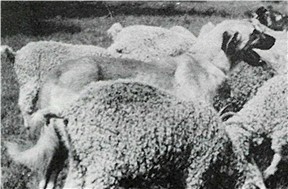
|
In 1984, with the help of Marilyn Harned, I purchased my first Anatolian,
Ebeling's Kasif (Casy) from Jean Ebeling. I had just lost eight ewes in two
weeks to coyotes and needed serious livestock protection 24/7. Jean took me
to a back pasture on her large ranch to show me Casy's sire, Pinarbasi's King,
an aloof male guarding her large flock of Angora goats without supervision.
I also met Casy's beautiful dam, Hanedan's Basbakan Bambi, a large-boned
working female.
Casy was seven weeks old when I brought him home and I knew next to nothing
about the breed. I kept the sheep and goats locked up in the barn with Casy
and then turned them all out together when Casy was only four months old (and
way too young to have the responsibility of guarding a herd alone). Casy
seemed to enjoy this new world and followed the herd as they grazed. His bark
sounded deep and scary, so I crossed my fingers and wished for the best.
I'm certain things turned out so well only because I'd purchased good working
genetics!
|
Being raised with goats from birth, Casy was strongly bonded to my flock.
He taught me that Anatolians with good working genetics who are raised in the
proper environment outgrow the play stage over time, even if they aren't
corrected every time they make a mistake.
Casy never lost an animal to a predator! Besides my sheep and goat herd (which
ranged between 50 and 200 animals over the years), Casy was responsible for
protecting my cats, chickens, ducks, geese, horses, llamas, and Simmental
cattle. On his own, Casy decided to protect my neighbor's newborn calves as
well. Although Casy was an intact male, he never left the property to visit
nearby females in heat. An Anatolian with an aloof and suspicious nature, like
Casy, tends to stay on territory and on the job.
A branch of Brushy Creek I called "The Coyote Highway" meandered along one side
of my property. Each night we could hear numerous coyote packs howling from
all directions - very scary. The cries of my kids and lambs were coyote
magnets, luring in coyotes day and night. Casy performed his rounds at least
twice a day - once in the morning and once in the evening - marking the pasture
boundaries carefully. Casy rarely returned with cuts and bite marks and blood
on Casy was generally from the predator.
|
Casy's Dam - HANEDAN'S Basbakan Bambi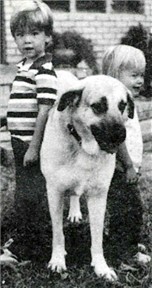
|
 Coyotes were not the only predators in the area. Wild hogs roamed our area and
frequently killed calves. Casy kept the wild hogs off my property year after
year, not only protecting my goats but all my other animals from their vicious
attacks.
Coyotes were not the only predators in the area. Wild hogs roamed our area and
frequently killed calves. Casy kept the wild hogs off my property year after
year, not only protecting my goats but all my other animals from their vicious
attacks.
The bobcats were perhaps my sneakiest predators. My neighbors kept their
poultry behind heavy fencing with tops and still had occasional bobcat losses.
However, with Casy on guard, my poultry were free roaming. My ducks and geese
enjoyed wandering around the pasture grazing on grass and swimming around the
pond freely. The chickens roosted in the barn without restraint. Skunks and
raccoons were also plentiful, but Casy never allowed them on the property to
steal eggs.
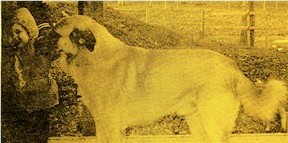 With no livestock predation, I almost forgot I lived in an area filled with
predators. Being able to forget that predators exist is the greatest reward
of owning a superior working Anatolian. With the perfect aloof attitude and
working demeanor of a great guardian, Casy protected my ranch, freeing me
from the daily battle to protect my animals.
With no livestock predation, I almost forgot I lived in an area filled with
predators. Being able to forget that predators exist is the greatest reward
of owning a superior working Anatolian. With the perfect aloof attitude and
working demeanor of a great guardian, Casy protected my ranch, freeing me
from the daily battle to protect my animals.
Through Casy, I developed the idea that the quality of an Anatolian Shepherd
Guardian Dog is measured by the quality of his working temperament and flock
guardian ability. Without working temperament and flock guarding ability, an
Anatolian is just a plain dog. Casy showed me that, in all cases, working
traits must be selected over traits helpful in the show ring but destructive
in a working environment.
To this day Casy continues to guard my ranch through his daughter,
granddaughters, and great granddaughters and grandsons.
|
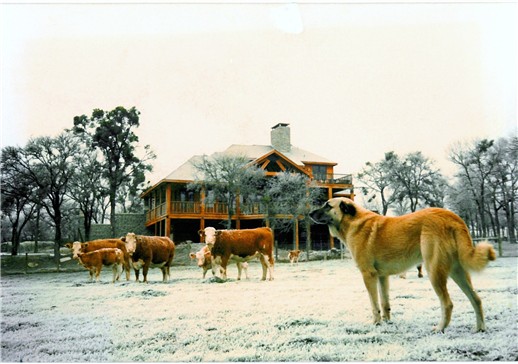
 and Phone Numbers Link
and Phone Numbers Link


 Coyotes were not the only predators in the area. Wild hogs roamed our area and
frequently killed calves. Casy kept the wild hogs off my property year after
year, not only protecting my goats but all my other animals from their vicious
attacks.
Coyotes were not the only predators in the area. Wild hogs roamed our area and
frequently killed calves. Casy kept the wild hogs off my property year after
year, not only protecting my goats but all my other animals from their vicious
attacks.  With no livestock predation, I almost forgot I lived in an area filled with
predators. Being able to forget that predators exist is the greatest reward
of owning a superior working Anatolian. With the perfect aloof attitude and
working demeanor of a great guardian, Casy protected my ranch, freeing me
from the daily battle to protect my animals.
With no livestock predation, I almost forgot I lived in an area filled with
predators. Being able to forget that predators exist is the greatest reward
of owning a superior working Anatolian. With the perfect aloof attitude and
working demeanor of a great guardian, Casy protected my ranch, freeing me
from the daily battle to protect my animals.  Click Picture to Return to Anatolian Main page
Click Picture to Return to Anatolian Main page
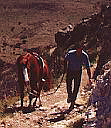 Click Picture to Return to Lucky Hit Main Home Page
Click Picture to Return to Lucky Hit Main Home Page